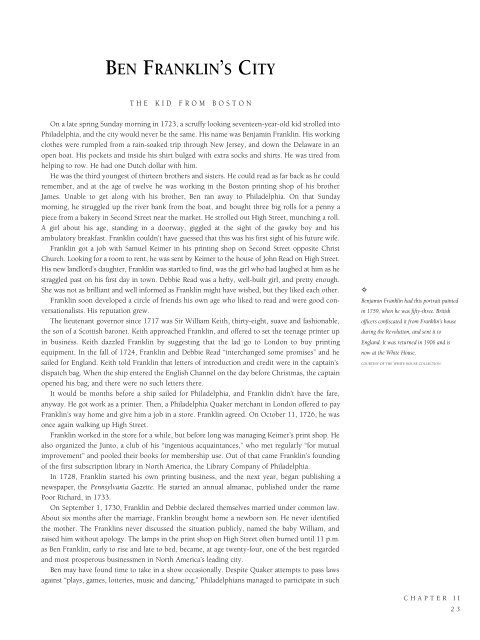Historic Philadelphia
An illustrated history of the city of Philadelphia, paired with the histories of companies, families and organizations that make the region great.
An illustrated history of the city of Philadelphia, paired with the histories of companies, families and organizations that make the region great.
You also want an ePaper? Increase the reach of your titles
YUMPU automatically turns print PDFs into web optimized ePapers that Google loves.
BEN FRANKLIN’S CITY<br />
THE KID FROM BOSTON<br />
On a late spring Sunday morning in 1723, a scruffy looking seventeen-year-old kid strolled into<br />
<strong>Philadelphia</strong>, and the city would never be the same. His name was Benjamin Franklin. His working<br />
clothes were rumpled from a rain-soaked trip through New Jersey, and down the Delaware in an<br />
open boat. His pockets and inside his shirt bulged with extra socks and shirts. He was tired from<br />
helping to row. He had one Dutch dollar with him.<br />
He was the third youngest of thirteen brothers and sisters. He could read as far back as he could<br />
remember, and at the age of twelve he was working in the Boston printing shop of his brother<br />
James. Unable to get along with his brother, Ben ran away to <strong>Philadelphia</strong>. On that Sunday<br />
morning, he struggled up the river bank from the boat, and bought three big rolls for a penny a<br />
piece from a bakery in Second Street near the market. He strolled out High Street, munching a roll.<br />
A girl about his age, standing in a doorway, giggled at the sight of the gawky boy and his<br />
ambulatory breakfast. Franklin couldn’t have guessed that this was his first sight of his future wife.<br />
Franklin got a job with Samuel Keimer in his printing shop on Second Street opposite Christ<br />
Church. Looking for a room to rent, he was sent by Keimer to the house of John Read on High Street.<br />
His new landlord’s daughter, Franklin was startled to find, was the girl who had laughed at him as he<br />
straggled past on his first day in town. Debbie Read was a hefty, well-built girl, and pretty enough.<br />
She was not as brilliant and well informed as Franklin might have wished, but they liked each other.<br />
Franklin soon developed a circle of friends his own age who liked to read and were good conversationalists.<br />
His reputation grew.<br />
The lieutenant governor since 1717 was Sir William Keith, thirty-eight, suave and fashionable,<br />
the son of a Scottish baronet. Keith approached Franklin, and offered to set the teenage printer up<br />
in business. Keith dazzled Franklin by suggesting that the lad go to London to buy printing<br />
equipment. In the fall of 1724, Franklin and Debbie Read “interchanged some promises” and he<br />
sailed for England. Keith told Franklin that letters of introduction and credit were in the captain’s<br />
dispatch bag. When the ship entered the English Channel on the day before Christmas, the captain<br />
opened his bag, and there were no such letters there.<br />
It would be months before a ship sailed for <strong>Philadelphia</strong>, and Franklin didn’t have the fare,<br />
anyway. He got work as a printer. Then, a <strong>Philadelphia</strong> Quaker merchant in London offered to pay<br />
Franklin’s way home and give him a job in a store. Franklin agreed. On October 11, 1726, he was<br />
once again walking up High Street.<br />
Franklin worked in the store for a while, but before long was managing Keimer’s print shop. He<br />
also organized the Junto, a club of his “ingenious acquaintances,” who met regularly “for mutual<br />
improvement” and pooled their books for membership use. Out of that came Franklin’s founding<br />
of the first subscription library in North America, the Library Company of <strong>Philadelphia</strong>.<br />
In 1728, Franklin started his own printing business, and the next year, began publishing a<br />
newspaper, the Pennsylvania Gazette. He started an annual almanac, published under the name<br />
Poor Richard, in 1733.<br />
On September 1, 1730, Franklin and Debbie declared themselves married under common law.<br />
About six months after the marriage, Franklin brought home a newborn son. He never identified<br />
the mother. The Franklins never discussed the situation publicly, named the baby William, and<br />
raised him without apology. The lamps in the print shop on High Street often burned until 11 p.m.<br />
as Ben Franklin, early to rise and late to bed, became, at age twenty-four, one of the best regarded<br />
and most prosperous businessmen in North America’s leading city.<br />
Ben may have found time to take in a show occasionally. Despite Quaker attempts to pass laws<br />
against “plays, games, lotteries, music and dancing,” <strong>Philadelphia</strong>ns managed to participate in such<br />
✧<br />
Benjamin Franklin had this portrait painted<br />
in 1759, when he was fifty-three. British<br />
officers confiscated it from Franklin’s house<br />
during the Revolution, and sent it to<br />
England. It was returned in 1906 and is<br />
now at the White House.<br />
COURTESY OF THE WHITE HOUSE COLLECTION.<br />
CHAPTER II<br />
23
















